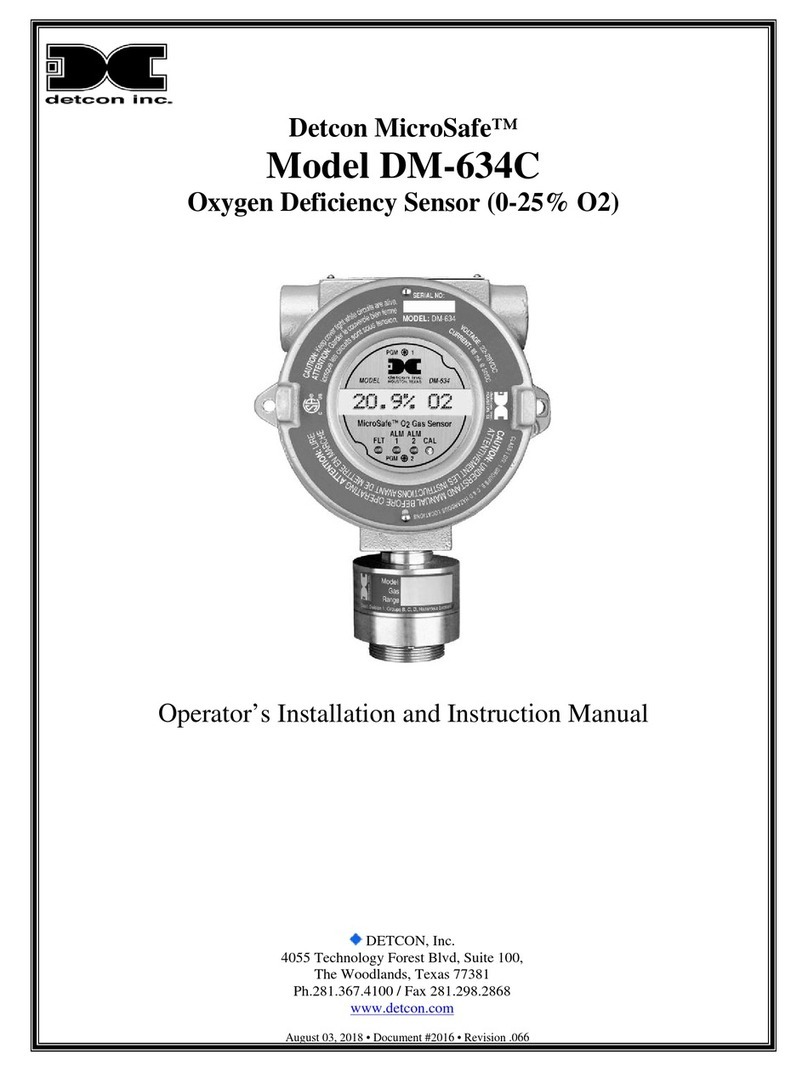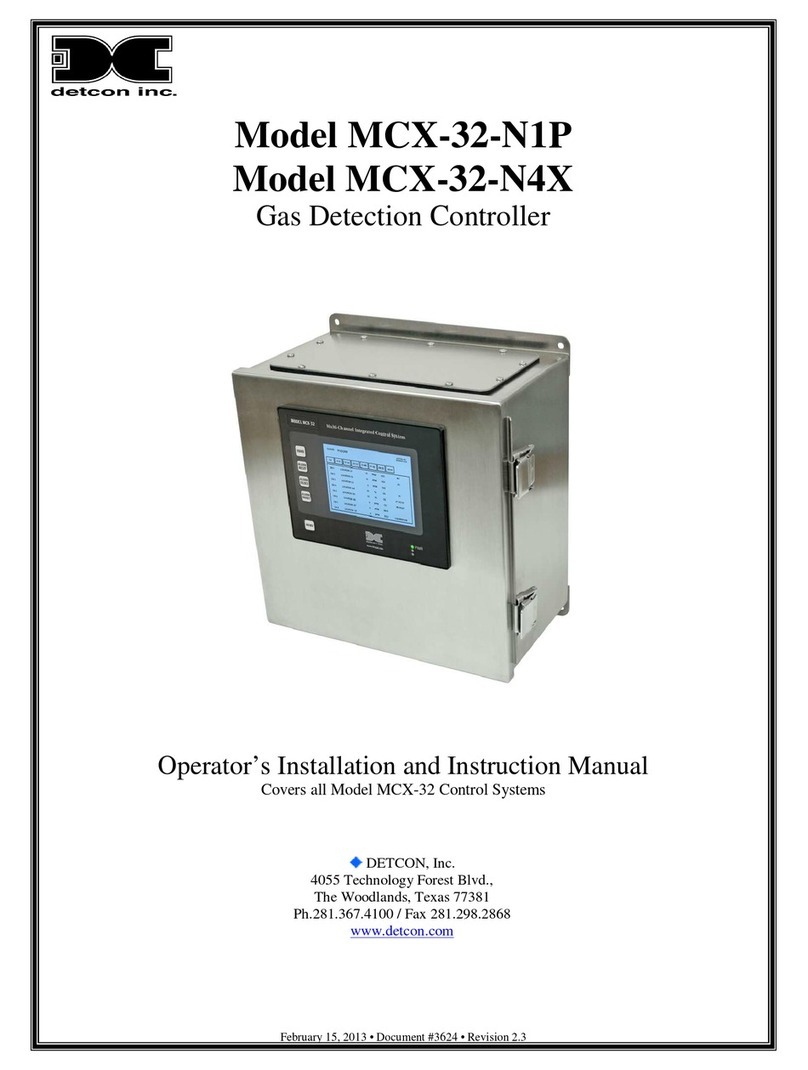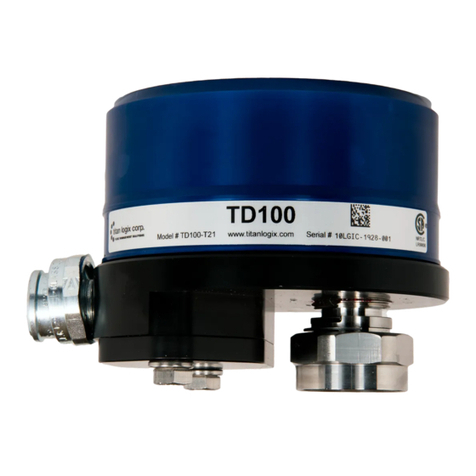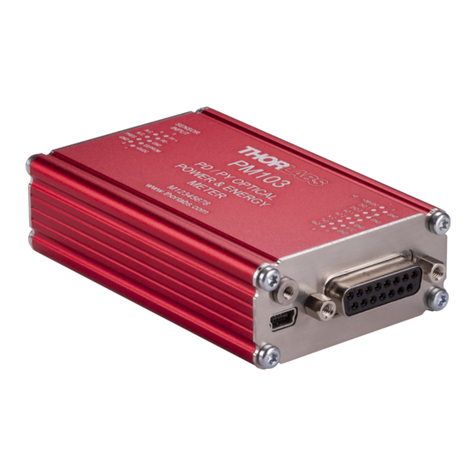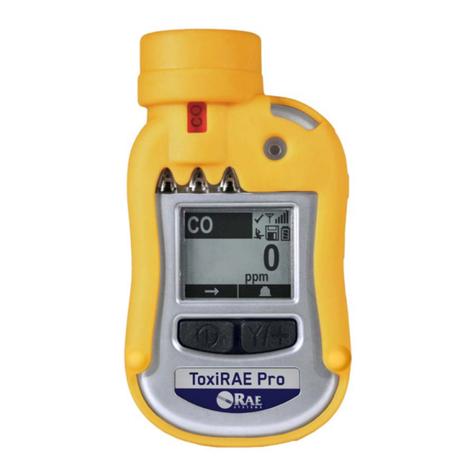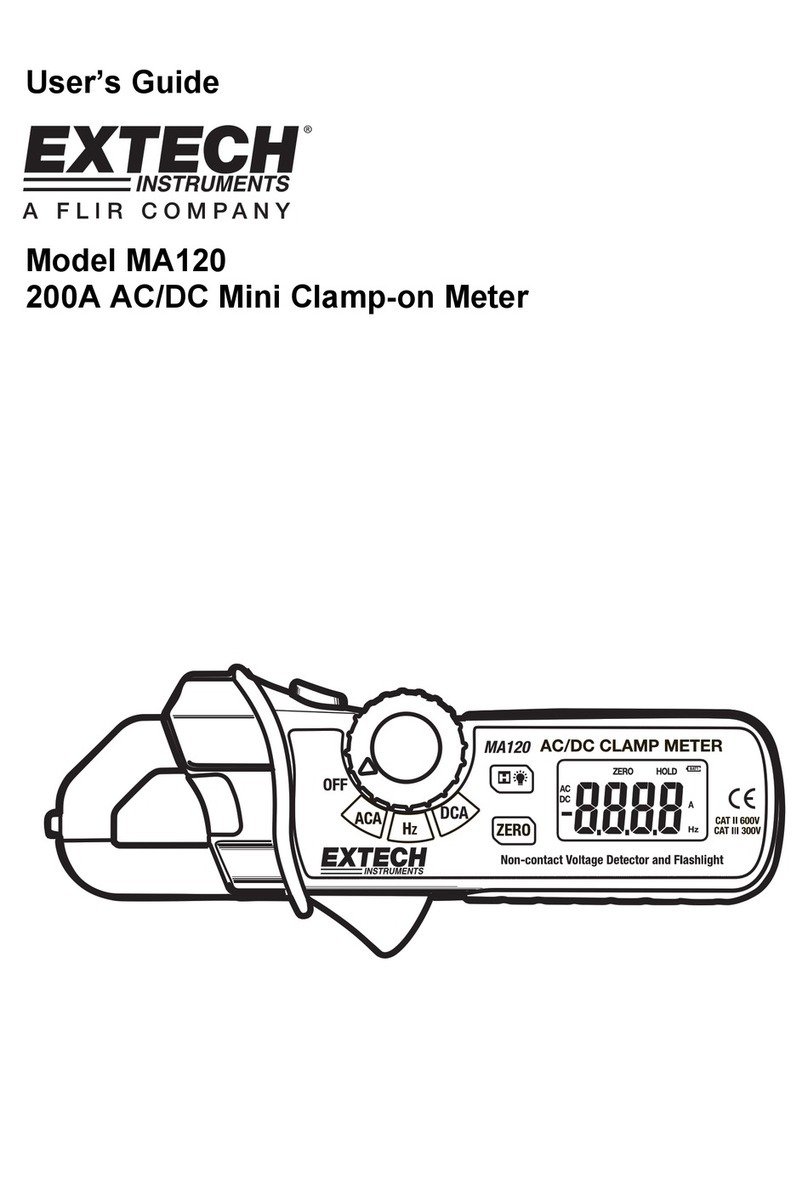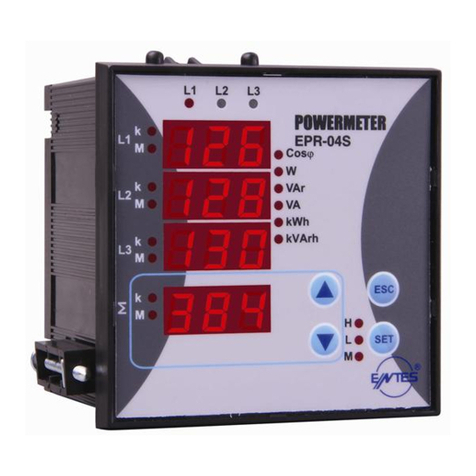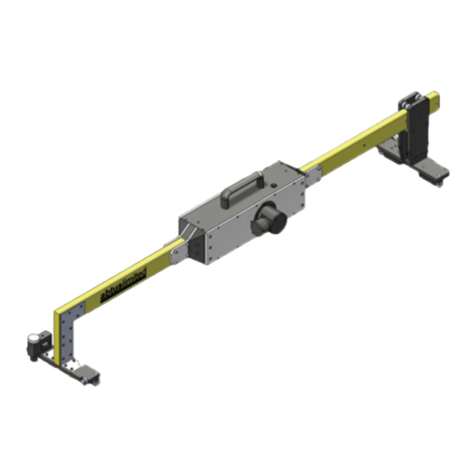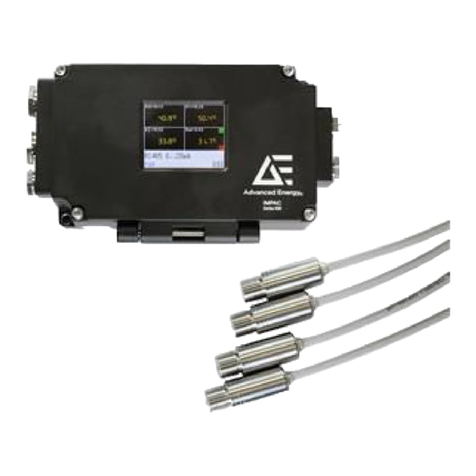Detcon 1000 User manual

Model 1000
H2S E-Chem/ CO2Process Analyzer
SAMPLE
FLOW AIR
FLOW
SAMPLE
FLOW
+ +
24VDC
OUT
2.1A
18-36
VDC
IN
Operator’s Installation and Instruction Manual
Detcon Model 1000 H2S/CO2Analyzer consists of two major assemblies:
1. The Model 1000 Series gas sample-conditioning assembly.
2. The Model DM-624 H2S Electrochemical and Model IR-640/IR642 CO2gas sensors.
DETCON, Inc.
4055 Technology Forest Dr. Suite 100,
The Woodlands, Texas 77387
Ph.281.367.4100 / Fax 281.298.2868
www.detcon.com
December 4, 2018• Document #3208• Revision 0.8

1000 H2S EChem/CO2
Model 1000 H2S E-Chem/CO2 Manual iii
Table of Contents
1. Introduction.............................................................................................................................................. 1
1.1 DM-624 Description (Sensor #1)......................................................................................................... 1
1.2 IR-640/IR-642 Description (Sensor #2)............................................................................................... 4
1.3 Enclosures ............................................................................................................................................ 7
2. Specifications............................................................................................................................................ 8
3. Installation................................................................................................................................................ 9
3.1 Mounting.............................................................................................................................................. 9
3.2 Gas Connections and Sampling System............................................................................................... 9
3.3 Electrical Connections........................................................................................................................ 12
3.4 Relays and RS-485 Setup (DM-624 and IR-640/IR-642).................................................................. 13
4. Start Up................................................................................................................................................... 15
5. Operating Software ............................................................................................................................... 18
5.1 Programming Magnet Operating Instructions.................................................................................... 18
5.2 Operating Software (DM-624)........................................................................................................... 18
5.2.1 Normal Operation ...................................................................................................................... 18
5.2.2 Calibration Mode....................................................................................................................... 19
5.2.3 Program Mode ........................................................................................................................... 19
5.2.4 Software Flow Chart .................................................................................................................. 21
5.3 Operating Software (IR-640/IR-642)................................................................................................. 22
5.3.1 Normal Operation ...................................................................................................................... 22
5.3.2 Calibration Mode....................................................................................................................... 22
5.3.3 Program Mode ........................................................................................................................... 22
5.3.4 Software Flow Chart .................................................................................................................. 24
6. Calibration.............................................................................................................................................. 25
6.1 DM-624 H2S Sensor Calibration........................................................................................................ 25
6.2 IR-640/IR-642 CO2Sensor Calibration.............................................................................................. 27
7. Programming Alarms............................................................................................................................ 29
7.1 Alarm Levels –DM-624 H2S Sensor................................................................................................. 29
7.2 Alarm Levels –IR-640/IR-642 CO2Sensor....................................................................................... 29
7.3 Alarm Reset (DM-624 and IR-640/IR-642)....................................................................................... 30
7.4 Other Alarm Functions....................................................................................................................... 30
8. Program Features.................................................................................................................................. 30
8.1 DM-624 H2S Sensor........................................................................................................................... 30
8.2 IR-640/IR-642 CO2Sensor................................................................................................................. 31
9. RS-485 Protocol ..................................................................................................................................... 32
10. Display Contrast Adjustment............................................................................................................... 34
11. Low Flow Fault Options........................................................................................................................ 34
12. Sensor Replacement............................................................................................................................... 34
12.1 Electrochemical –DM-624 H2S Sensor............................................................................................. 34
12.2 Optical Sensor –IR-640/IR-642 CO2Sensor..................................................................................... 35
13. Troubleshooting..................................................................................................................................... 35
13.1 DM-624 H2S Sensor........................................................................................................................... 35
13.2 IR-640/IR-642 CO2Sensor................................................................................................................. 36
14. Spare Parts............................................................................................................................................. 37
15. Warranty................................................................................................................................................ 41
16. Flow Diagrams....................................................................................................................................... 42
17. Wiring Diagram..................................................................................................................................... 45
Appendix C....................................................................................................................................................... 46
Revision Log .................................................................................................................................................. 46

1000 H2S EChem/CO2
Model 1000 H2S E-Chem/CO2 Manual iv
Table of Figures
Figure 1 DM-624.................................................................................................................................................. 1
Figure 2 Construction of Electrochemical Sensor................................................................................................ 2
Figure 3 Functional Block Diagram..................................................................................................................... 3
Figure 4 DM-624 Control Circuit ........................................................................................................................ 3
Figure 5 Connector Board Terminals................................................................................................................... 3
Figure 6 IR-640.................................................................................................................................................... 4
Figure 7 Sensor Diagram...................................................................................................................................... 5
Figure 8 Response Curve ..................................................................................................................................... 5
Figure 9 Principle of operation............................................................................................................................. 6
Figure 10 Functional Block Diagram................................................................................................................... 6
Figure 11 Control Circuit..................................................................................................................................... 7
Figure 12 Connector Board Terminals................................................................................................................. 7
Figure 13 Enclosures............................................................................................................................................ 8
Figure 14 Unit Dimensions .................................................................................................................................. 9
Figure 15 Port Identification .............................................................................................................................. 10
Figure 16 Port Identification with Dilution........................................................................................................ 11
Figure 17 Installation Wiring Connections ........................................................................................................ 12
Figure 18 Alarm Jumpers................................................................................................................................... 13
Figure 19 RS-485 Dip Switches......................................................................................................................... 14
Figure 20 Rotameters and Gas Connections ...................................................................................................... 16
Figure 21 Rotameters and Gas Connections with Air Dilution.......................................................................... 17
Figure 22 Programming Magnet ........................................................................................................................ 18
Figure 23 DM-624 Software Flow Chart ........................................................................................................... 21
Figure 24 IR-640/IR/642 Software Flow Chart.................................................................................................. 24
Figure 25 DM-624 Replacement Parts............................................................................................................... 37
Figure 26 IR-640/IR-642 Replacement Parts..................................................................................................... 38
Figure 27 Analyzer Spare Parts.......................................................................................................................... 39
Figure 28 Analyzer with Air Dilution Spare Parts............................................................................................. 40
Figure 29 Unit Flow Diagram............................................................................................................................ 42
Figure 30 Unit Flow Diagram with dilution....................................................................................................... 43
Figure 31 Pump Box Flow Diagram .................................................................................................................. 44
Figure 32 Wiring Diagram................................................................................................................................. 45

1000 H2S EChem/CO2
Model 1000 H2S E-Chem/CO2 Manual Rev 0.8 Page 1 of 47
1. Introduction
The Detcon Model 1000 Series H2S/CO2Process Analyzer is a 110/220VAC or 24VDC powered analyzer that
provides a select gas sample mixture to on-board DM-624 H2S and IR-640/IR-642 CO2gas sensor assemblies.
The ranges of analysis are determined at time of order.
When located outdoors, the H2S/CO2Process Analyzer package should be appropriately covered from direct
weather exposure. The Model 1000 Series H2S/CO2Process Analyzer can optionally be ordered with a full
NEMA 4 enclosure.
The “Power Supply” enclosure on the upper right side of the unit houses a 24 VDC power supply, a 24V DC-
DC Converter, and a terminal PCB labeled for all input and output field wiring. The “Pump/Flow” enclosure
located on the upper left houses an air dilution pump, an activated carbon scrubber, and optional air flow fault
and sample flow fault alarm PCB’s.
The analyzer requires a constant, liquid-free, 10±2 psig sample pressure, which is provided by the customer or
may be supplied by Detcon as a separate gas sample handling system.
The on-board gas sample conditioning system includes a stainless steel pressure gauge (0-30 psig), and a Genie
membrane filter to provide the analyzer with absolute condensate liquid protection. On the bypass port of the
Genie membrane filter, a 15 psig over-pressure relief valve and flow control valve are also provided. The flow
control valve can be usedas a sample bypass andliquid exhaust vent. A two part air and one part sample mixture
is maintained and delivered to the Model DM-624 H2S for analysis. The IR-640/IR-642 CO2gas sensor
measures the sample directly, except in units that utilize Air dilution. The IR-640 0-15% range units that utilize
air dilution for the CO2use the same 2 part air and one part sample mixture as the H2S sensor. The H2S sample
flow is maintained by a constant-flow ‘Mass Flow controller’ and an associated rotameter, while airflow is
maintained by a control valve rotameter. The sample for the CO2sensor is set by a control valve rotameter. One
or Two 3-way valves are provided for manually switching between sample monitoring and span calibrations.
1.1 DM-624 Description (Sensor #1)
Figure 1 DM-624

1000 H2S EChem/CO2
Model 1000 H2S E-Chem/CO2 Manual Rev 0.8 Page 2 of 47
Detcon MicroSafe™ Model DM-624, toxic sensors are non-intrusive “Smart” sensors designed to detect and
monitor for H2S gas in parts per million (ppm). One of the primary features of the sensor is its method of
automatic calibration, which guides the user through each step via instructions displayed on the backlit LCD.
The sensor features field adjustable, fully programmable alarms and provides relays for two alarms plus fault as
standard. The sensor comes with two different outputs: analog 4-20mA, and serial RS-485. These outputs allow
for greater flexibility in system integration and installation. The microprocessor-supervised electronics are
packaged as a plug-in module that mates to a standard connector board. Both are housed in a condulet that
includes a glass lens window, which allows for the display of sensor readings as well as access to the sensor’s
menu driven features via a hand-held programming magnet.
Electrochemical Sensor
The sensor is an electrochemical cell. Each cell consists of three electrodes embedded in an electrolyte solution
all housed beneath a diffusion membrane. Sensitivity to specific target gases is achieved by varying composition
of any combination of the sensor components. Good specificity is achieved in each sensor type. The cell is
diffusion limited via small capillary barriers resulting in long service life of up to 3 or more years depending on
the application.
NOTE: This particular sensor cell is unique in that it has no cross-sensitivity to alcohol vapors and thus is
a good choice for measuring H2S in natural gas pipelines.
Figure 2 Construction of Electrochemical Sensor
DM-624 Electrochemical Sensor Principle of Operation
Method of detection is by an electrochemical reaction at the surface of an electrode called the sensing electrode.
Air and gas diffuse through the stainless steel filter and the capillary diffusion barrier. The controlling circuit
maintains a small external operating voltage between the sensing and counter electrodes of the proper bias and
magnitude so that no current flows to or from the reference electrode while its potential is maintained at the
correct fixed voltage —usually ground. The electrochemical reaction creates a change in current flow from the
counter electrode to the sensing electrode. This change in current is proportional to the gas concentration and is
reversible. The quick response of the sensor results in continuous monitoring of ambient air conditions.
Microprocessor Control Circuit
The control circuit is microprocessor based, and is packaged as a plug-in field replaceable module, facilitating
easy replacement and minimum down time. Circuit functions include a basic sensor pre-amplifier, on-board
power supplies, microprocessor, back lit alpha numeric display, alarm status LED indicators, magnetic
programming switches, an RS-485 communication port, and a linear 4-20 mA DC output.

1000 H2S EChem/CO2
Model 1000 H2S E-Chem/CO2 Manual Rev 0.8 Page 3 of 47
Figure 3 Functional Block Diagram
Figure 4 DM-624 Control Circuit
Base Connector Board
The base connector board is mounted in the enclosure and includes: the mating connector for the control circuit,
reverse input and secondary transient suppression,input filter, alarm relays, lugless terminals for all field wiring,
and a terminal strip for storing unused programming jumper tabs. The alarm relays are contact rated 5 amps @
250 VAC, 5 amps @ 30 VDC and coil rated at 24 VDC. Gold plated program jumpers are used to select either
the normally open or normally closed relay contacts.
Figure 5 Connector Board Terminals

1000 H2S EChem/CO2
Model 1000 H2S E-Chem/CO2 Manual Rev 0.8 Page 4 of 47
Interference Data
DM-624 series electrochemical sensors are subject to interference from other gases. This interaction is shown
in the following table as the relation between the amount of the interfering gas applied to the sensor, and the
corresponding reading that will occur (in ppm).
Gas Interference
Carbon monoxide 300ppm 1.5ppm
Chlorine 1ppm = -0.2ppm
Ethyl mercaptan 3ppm = 1ppm
Ethylene 100ppm = 0
Hydrogen 1% = < 5ppm
Hydrogen chloride 5ppm = 0
Hydrogen cyanide 10ppm = 0
Nitric oxide 35ppm < 2ppm
Nitrogen dioxide 5ppm = -0.5ppm
Sulfur dioxide 5ppm < 1ppm
Methyl mercaptan 2ppm = 1ppm
1.2 IR-640/IR-642 Description (Sensor #2)
Figure 6 IR-640
Detcon MicroSafe™ Model IR-640 carbon dioxide gas sensors are non-intrusive “Smart” sensors designed to
detect and monitor CO2gas in the 0-5% range. Using air dilution, the IR-640 can be used to measure 0-15%.
The Detcon Model IR-642 is used to measure CO2gas in ranges from 0-10% up to 0-100% without air dilution.
One of the primary features of the sensors is its method of automatic calibration, which guides the user through
each step via instructions displayed on the backlit LCD. The sensor features field adjustable, fully programmable
alarms, and provides relays for two alarms plus fault as standard. The sensor comes with two different outputs:
analog 4-20mA, and serial RS-485. These outputs allow for greater flexibility in system integration and
installation. The microprocessor-supervised electronics are packaged as a plug-in module that mates to a
standard connector board. Both are housed in an condulet that includes a glass lens window, which allows for
the display of sensor readings as well as access to the sensor’s menu driven features via a hand-held
programming magnet.

1000 H2S EChem/CO2
Model 1000 H2S E-Chem/CO2 Manual Rev 0.8 Page 5 of 47
The sensor technology is a field proven “plug-in replaceable” non-dispersive infrared (NDIR) optical type.
NDIR optical sensors show an excellent response to CO2. The NDIR type sensor is characteristically stable for
both span and zero and is capable of providing reliable performance with low maintenance requirements for
periods approaching 5 years in most industrial environments.
Figure 7 Sensor Diagram
Non-dispersive infrared (NDIR) optical sensor
The Detcon NDIR sensor is designed as a miniature single piece “plug-in replaceable” component, which can
easily be changed out in the field. The NDIR sensor consists of an infrared lamp source, two pyroelectric
detectors, and an optical gas sample cavity. The lamp source produces infrared radiation, which interacts with
CO2as it travels through the optical gas sample cavity. The infrared radiation contacts each of two pyroelectric
detectors at the completion of the optical path. The “active” pyroelectric detector is cove red by a filter specific
to the part of the IR spectrum where CO2absorbs light. The “reference” pyroelectric detector is covered by a
filter specific to the non-absorbing part of the IR spectrum. When CO2is present, it absorbs IR radiation and
the signal output from the “active” pyroelectric detector decreases accordingly while the “reference” detector
output remains unchanged. The ratio of the “active” and “reference” detector outputs is then used to compute
CO2concentration.
Figure 8 Response Curve
Infrared Sensor Principal of Operation
CO2in the sample stream diffuses through a sintered stainless steel flame arrestor and into the volume of the
sample gas optical cavity. A lamp source provides a cyclical IR radiation source, which travels through the
optical gas sample cavity and terminates at two pyroelectric detectors. The “active” and “reference” pyroelectric

1000 H2S EChem/CO2
Model 1000 H2S E-Chem/CO2 Manual Rev 0.8 Page 6 of 47
detectors each give an output, which measures the intensity of the radiation contacting their surface. The “active”
pyroelectric detector is covered by an optical filter specific to the part of the IR spectrum where CO2absorbs
light. The “reference” pyroelectric detector is covered by a filter specific to the non-absorbing part of the IR
spectrum. When present, CO2absorbs a fraction of the IR radiation and the signal output from the “active”
pyroelectric detector decreases accordingly. The signal output of the “reference” detector remains unchanged
in the presence of CO2. The ratio of the “active” and “reference” detector signal outputs is then used to compute
CO2concentration. By using the ratio of the active/reference signal outputs, measurement drift caused by
changes in the intensity of the lamp source and changes in the optical path are negated.
Figure 9 Principle of operation
Characteristics
The NDIR optical sensor element maintains strong sensitivity to CO2, as shown in the Figure 9. Typical zero
calibration intervals would be quarterly and typical span calibration intervals would be quarterly to bi-annual.
However, actual field experience is always the best determination of appropriate calibration intervals.
The NDIR optical sensor readings can be adversely affected by dust, dirt and oil mist accumulation as well as
severe corrosion. These deposits may reduce the optical reflectivity inside the sensor, and although accurate
readings are continually maintained, excessive loss in useable signal eventually gives way to noise and unstable
readings. The optical sensor may, over a long period of time (3-7 years), lose its IR lamp source filament, and
in this case, an optical sensor modular replacement is required. The IR-640/IR-642 has an extensive list of Fault
Diagnostics to alert and pinpoint operational problems. See section 13 Troubleshooting,
Microprocessor Control Circuit
The control circuit is microprocessor based and packaged as a plug-in field replaceable module, facilitating easy
replacement and minimum down time. Circuit functions include a basic sensor pre-amplifier, sensor temperature
measurement, on-board power supplies, microprocessor, back lit alpha numeric display, alarm status LED
indicators, magnetic programming switches, an RS-485 communication port, and a linear 4-20mA DC output.
Figure 10 Functional Block Diagram

1000 H2S EChem/CO2
Model 1000 H2S E-Chem/CO2 Manual Rev 0.8 Page 7 of 47
Figure 11 Control Circuit
Base Connector Board
The base connector board is mounted in the enclosure and includes: the mating connector for the control circuit,
reverse input and secondary transient suppression, input filter, alarmrelays, lug less terminals for all field wiring,
and a terminal strip for storing unused programming jumper tabs. The alarm relays are contact rated 5Amps @
250 VAC, 5Amps @ 30 VDC and coil rated at 24VDC. Gold plated program jumpers are used to select either
the normally open or normally closed relay contacts.
Jumper
programmable
Alarm Outputs
VDC Power In
4-20mA Output
RS-485 In
RS-485 Out
Alarm Dry Contacts
Sensor input
Optional 4-20mA Signal
Developing Resistor
Optional RS-485
Terminating Resistor
Unused Jumper Tabs
Figure 12 Connector Board Terminals
1.3 Enclosures
The sensors are packaged in cast metal enclosures. The enclosures are fitted with a threaded cover with glass
lens window. Magnetic program switches located behind the transmitter module faceplate are activated through
the lens window via a hand-held magnetic programming tool allowing non-intrusive operator interface with the
sensor. All calibration and alarm level adjustments can be accomplished without removing the cover.

1000 H2S EChem/CO2
Model 1000 H2S E-Chem/CO2 Manual Rev 0.8 Page 8 of 47
++
24VDC
OUT
2.1A
18-36
VDC
IN
Flow Fault (optional)
Pump/Scrubber Power Supply/
Terminal PCB Sensor (side view) Sensor
Right
Left
Figure 13 Enclosures
A 24 VDC power supply and termination PCB for the power, relay contacts, 4-20mA output, and or RS485
signal, are located in the enclosure located in the upper right of the unit. The pump, activated carbon scrubber
and optional low flow fault assembly are located in the enclosure located in the upper right of the unit.
2. Specifications
Sensor Type
Electrochemical cell (DM-624 H2S Sensor)
Non-Dispersive Infrared (IR-640/IR-642 CO2Sensor)
Measurement Range
0-10ppm H2S, up to0-5% H2S (DM-624 H2S Sensor)
0.3% up to 5% (IR-640 CO2Sensor)
0-15% using 3:1 air dilution (IR-640 CO2Sensor)
10% up to 100% (IR-642 CO2Sensor)
Accuracy/Repeatability
± 10% of reading or ±0.5 ppm, whichever is greater (DM-624 H2S Sensor)
± 5% Full Scale (IR-640/IR-642/IR642 CO2Sensor)
Response/Clearing Time
T80 < 1 minute (DM-624 H2S Sensor)
T50<30 seconds, T80<60 seconds (IR-640/IR-642 CO2Sensor)
Operating Temperature
-40°C to +50°C
Operating Pressure:
Inlet: 10±2psig
Outlet: Ambient±1psig
Outputs
Linear 4-20mA DC; RS-485 Modbus™; 3 relays (alarm 1, alarm 2, and fault), Contacts rated 5 amps (both
sensors)
Sensor Life/Warranty
Sensor: 6 month conditional warranty; Transmitter: 2 year warranty (DM-624 H2S Sensor)
Sensor: 5-year conditional warranty. Transmitter: 2-year warranty (IR-640/IR-642 CO2Sensor)
Input Voltage
117/220VAC; 18-36VDC
Power Consumption
925mA max (22.2Watts), 300 mA nominal (7.2 Watts) @ 24VDC
Electrical Classification
Non Hazardous Area

1000 H2S EChem/CO2
Model 1000 H2S E-Chem/CO2 Manual Rev 0.8 Page 9 of 47
Analyzer Weight
75 lbs.
Dimensions
29”H X 29”W X 8”D
3. Installation
3.1 Mounting
Securely mount the Model 1000 analyzer panel or NEMA 4 enclosure (optional) in accordance with Figure 14.
Figure 14 Unit Dimensions
3.2 Gas Connections and Sampling System
1. Install a length of tubing from the desired sample point to the sample inlet port as shown in Figure 15.
Sample draw tubing should be 316 stainless steel of 1/4" O.D.
NOTE: A constant pressure of 10-±2 psig should be provided to the analyzer for proper operation. In
applications where line pressure varies significantly, two-stage pressure regulation is recommended to hold
the constant pressure. Ideally, the pressure drop from the source to 10 psig for analyzer should be taken as
close to the pipeline as possible. This speeds up response time to actual gas concentration changes. An
insertion probe membrane device is advisable to use for pipeline sources with high levels of condensates,
mist, and contamination.

1000 H2S EChem/CO2
Model 1000 H2S E-Chem/CO2 Manual Rev 0.8 Page 10 of 47
INLET
SAMPLE
10 PSIG (CONSTANT)
SAMPLE PRESSURE
INLET
AIR AIR
INLET
SAMPLE OUTLET
SAMPLE
SAMPLE
FLOW AIR
FLOW
SAMPLE
FLOW
MODEL NO.
SERIAL NO.
INPUT VOLTAGE
FREQUENCY
CURRENT LOAD
AREA CLASSIFICATION
detcon inc.
3200 A-1 Research ForestDr.
TheW oodlands,TX 77381
www.detcon.com
PART NO.
Air inlet port
Pressure Gauge
Over-pressure Relief Vent
Sample Bypass and Liquid Rejection Exhaust Vent
*NOTE: These can be combined to a single vent
Cal Gas CO2
Cal Gas H2S Vent
Port H2S Vent
Port CO2
Sample Inlet Port
Figure 15 Port Identification

1000 H2S EChem/CO2
Model 1000 H2S E-Chem/CO2 Manual Rev 0.8 Page 11 of 47
INLET
SAMPLE
10 PSIG (CONSTANT)
SAMPLE PRESSURE
INLET
AIR AIR
INLET
SAMPLE OUTLET
SAMPLE
AIR
FLOW
MODEL NO.
SERIAL NO.
INPUT VOLTAGE
FREQUENCY
CURRENT LOAD
AREA CLASSIFICATION
detcon inc.
3200 A-1 Research ForestDr.
TheW oodlands,TX 77381
www.detcon.com
PART NO.
SAMPLE
FLOW
Air inlet port
Pressure Gauge
Over-pressure Relief Vent
Sample Bypass and Liquid Rejection Exhaust Vent
*NOTE: These can be combined to a single vent
Cal Gas
H2S/CO2 Vent Port
Sample Inlet Port
Figure 16 Port Identification with Dilution
2. Whenever possible, the Sample Bypass flow control valve of the Genie membrane filter should be used to
minimize the sample lag time between the sample tap and the analyzer location. It can also be used as a
means to exhaust condensed liquids in the sample line away from the Genie filter and prevent a “loss of
flow” condition. Set a flow of 100-200cc/min. and vent to a safe area using ¼ O.D. tubing.
3. Connect to the Over-pressure Relief valve and vent to a safe area. The pressure relief valve is set at Detcon
to open at 15-20psig. For convenience sake, the sample bypass and over-pressure relief can be vented
together.
4. Install a length of 1/4" OD stainless steel tubing from the vent port to an area deemed safe for venting as
shown below. The sensor vent ports can be tied together, but should be separately vented from the over-
pressure relief vent and the sample by-pass vent.
5. The Air Inlet Port should remain open and un-obstructed. In some cases, the user may opt to operate on
instrument air instead of ambient air provided by the pump. In this case, the instrument air must be regulated
to a constant pressure of 5psig. The instrument air (because it is extremely dry) must be passed through a
humidifying tube. (See Detcon for details.)

1000 H2S EChem/CO2
Model 1000 H2S E-Chem/CO2 Manual Rev 0.8 Page 12 of 47
3.3 Electrical Connections
1. For AC powered unit connect 117/220VAC to the terminal connector labeled “VAC IN” (JP8A) inside the
enclosure on the right. If applicable, connect 24VDC to the Terminal Connector Board labeled “VDC IN”
(JP7A) (Figure 17).
2. The 4-20mA and/or RS-485 signal outputs should be wired from the terminal PCB and then out the right
side of the “Power Supply” enclosure (Figure 17).
SAMPLE
FLOW AIR
FLOW
SAMPLE
FLOW
+ +
24VDC
OUT
2.1A
18-36
VDC
IN
++
24VDC
OUT
2.1A
18-36
VDC
IN
++
24VDC
OUT
2.1A
18-36
VDC
IN
4-20mA, RS485,
Alarm/Fault Sensor Relays
Low Flow Air/ Sample Relays
(Optional)
117VAC / 24VDC In
Customer Connections
+24VDC
-24VDC
(Ground)
INPUT
+
-
Figure 17 Installation Wiring Connections
3. Discrete alarm relay contacts are provided for three alarms: Fault, Low and High. The contacts consist of
common and choice of normally open or normally closed. Contact output selections are jumper
programmable on the sensor connector board. See DM-624 and IR-640/IR-642 wiring diagram for details.

1000 H2S EChem/CO2
Model 1000 H2S E-Chem/CO2 Manual Rev 0.8 Page 13 of 47
These connections also should be wired out of the right side of the “Power Supply” enclosure. See wiring
diagram for detail. Sensor #1 termination corresponds to DM-624 H2S Sensor. Sensor #2 corresponds to
IR-640/IR-642 CO2Sensor.
4. Optional Low Flow Fault alarms for Sample gas and Air are available. They provide a form “C” relay
contact (common, normally open and normally closed) rated 1 amp at 30 VDC/0.24 amp at 125 VAC. Relay
contacts are pre-wired to the I/O connector PCB located in the “Power Supply” enclosure.
3.4 Relays and RS-485 Setup (DM-624 and IR-640/IR-642)
Program the alarms via the gold plated jumper tab positions located on the CPU board (Figure 18). Alarm 1 and
Alarm 2 have three jumper programmable functions: latching/non-latching relays, normally energized/normally
de-energized relays, and ascending/descending alarm set points. The fault alarm has two jumper programmable
functions: latching/non-latching relay, and normally energized/normally de-energized relay. The default settings
of the alarms (jumpers removed) are normally de-energized relays, non-latching relays, and alarm points that
activate during descending gas conditions.
Figure 18 Alarm Jumpers
If a jumper tab is installed in the latch position, then that alarm relay will be in the latching mode. The latching
mode will latch the alarm after alarm conditions have cleared until the alarm reset function is activated. The
non-latching mode (jumper removed) will de-activate alarms automatically once alarm conditions have cleared.
If a jumper tab isinstalled in the energize position,that alarmrelay will be in the energized mode. The energized
mode will energize or activate the alarm relay when there is no alarm condition and de-energize or de-activate
the alarm relay when there is an alarm condition. The de-energized mode (jumper removed) will energize or
activate the alarm relay during an alarm condition and de-energize or de-activate the alarm relay when there is
no alarm condition.
If a jumper tab is installed in the ascending position, then that alarm relay will be in the ascending mode. The
ascending mode will cause an alarm to fire when the gas concentration detected is greater than or equal to the
alarm set point. The descending mode (jumper removed) will cause an alarm to fire when the gas concentration
detected is lesser than or equal to the alarm set point. Except in special applications, H2S and CO2monitoring
will require alarms to fire in “ASCENDING” gas conditions.
Any unused jumper tabs should be stored on the connector board on the terminal strip labeled “Unused Jumpers”.
If applicable, set the RS-485 ID number via the two rotary dip switches located on the preamp board (Figure
19). There are 256 different ID numbers available, which are based on the hexadecimal numbering system. If
RS-485 communications are used, each sensor must have its own unique IDnumber. Use a jeweler’s screwdriver

1000 H2S EChem/CO2
Model 1000 H2S E-Chem/CO2 Manual Rev 0.8 Page 14 of 47
to set the rotary dipswitches according to the hexadecimal table listed below. If RS-485 communications are
not used, leave the dipswitches in the default position, which is zero/zero (0)-(0).
Figure 19 RS-485 Dip Switches
Replace the plug-in control circuit and replace the junction box cover.
Hexadecimal Table 1
ID#
SW1
SW2
ID#
SW1
SW2
ID#
SW1
SW2
ID#
SW1
SW2
ID#
SW1
SW2
ID#
SW1
SW2
none
0
0
43
2
B
86
5
6
129
8
1
172
A
C
215
D
7
1
0
1
44
2
C
87
5
7
130
8
2
173
A
D
216
D
8
2
0
2
45
2
D
88
5
8
131
8
3
174
A
E
217
D
9
3
0
3
46
2
E
89
5
9
132
8
4
175
A
F
218
D
A
4
0
4
47
2
F
90
5
A
133
8
5
176
B
0
219
D
B
5
0
5
48
3
0
91
5
B
134
8
6
177
B
1
220
D
C
6
0
6
49
3
1
92
5
C
135
8
7
178
B
2
221
D
D
7
0
7
50
3
2
93
5
D
136
8
8
179
B
3
222
D
E
8
0
8
51
3
3
94
5
E
137
8
9
180
B
4
223
E
F
9
0
9
52
3
4
95
5
F
138
8
A
181
B
5
224
E
0
10
0
A
53
3
5
96
6
0
139
8
B
182
B
6
225
E
1
11
0
B
54
3
6
97
6
1
140
8
C
183
B
7
226
E
2
12
0
C
55
3
7
98
6
2
141
8
D
184
B
8
227
E
3
13
0
D
56
3
8
99
6
3
142
8
E
185
B
9
228
E
4
14
0
E
57
3
9
100
6
4
143
8
F
186
B
A
229
E
5
15
0
F
58
3
A
101
6
5
144
9
0
187
B
B
230
E
6
16
1
0
59
3
B
102
6
6
145
9
1
188
B
C
231
E
7
17
1
1
60
3
C
103
6
7
146
9
2
189
B
D
232
E
8
18
1
2
61
3
D
104
6
8
147
9
3
190
B
E
233
E
9
19
1
3
62
3
E
105
6
9
148
9
4
191
B
F
234
E
A
20
1
4
63
3
F
106
6
A
149
9
5
192
C
0
235
E
B
21
1
5
64
4
0
107
6
B
150
9
6
193
C
1
236
E
C
22
1
6
65
4
1
108
6
C
151
9
7
194
C
2
237
E
D
23
1
7
66
4
2
109
6
D
152
9
8
195
C
3
238
E
E
24
1
8
67
4
3
110
6
E
153
9
9
196
C
4
239
F
F
25
1
9
68
4
4
111
6
F
154
9
A
197
C
5
240
F
0
26
1
A
69
4
5
112
7
0
155
9
B
198
C
6
241
F
1
27
1
B
70
4
6
113
7
1
156
9
C
199
C
7
242
F
2
28
1
C
71
4
7
114
7
2
157
9
D
200
C
8
243
F
3
29
1
D
72
4
8
115
7
3
158
9
E
201
C
9
244
F
4
30
1
E
73
4
9
116
7
4
159
9
F
202
C
A
245
F
5
31
1
F
74
4
A
117
7
5
160
A
0
203
C
B
246
F
6
32
2
0
75
4
B
118
7
6
161
A
1
204
C
C
247
F
7
33
2
1
76
4
C
119
7
7
162
A
2
205
C
D
248
F
8
34
2
2
77
4
D
120
7
8
163
A
3
206
C
E
249
F
9
35
2
3
78
4
E
121
7
9
164
A
4
207
C
F
250
F
A
36
2
4
79
4
F
122
7
A
165
A
5
208
D
0
251
F
B
37
2
5
80
5
0
123
7
B
166
A
6
209
D
1
252
F
C
38
2
6
81
5
1
124
7
C
167
A
7
210
D
2
253
F
D
39
2
7
82
5
2
125
7
D
168
A
8
211
D
3
254
F
E
40
2
8
83
5
3
126
7
E
169
A
9
212
D
4
255
F
F
41
2
9
84
5
4
127
7
F
170
A
A
213
D
5
42
2
A
85
5
5
128
8
0
171
A
B
214
D
6

1000 H2S EChem/CO2
Model 1000 H2S E-Chem/CO2 Manual Rev 0.8 Page 15 of 47
4. Start Up
Upon completion of all tubing connections and field wiring the Model 1000 Series Process Analyzer is ready
for startup. Note that after power is applied, varying readings may occur during sensor warm-up. Allow at least
1 hour to stabilize (24 hours is best). With sample gas and airflows properly set, apply system power and observe
the following normal conditions:
a) DM-624 “Fault” LED is off
b) IR-640/IR-642 “Fault” LED is off
c) A reading close to the anticipated CO2and H2S level should be indicated upon conclusion of a 1-hour “warm
up” cycle.
NOTE: All alarms will be disabled for 1 minute after power up. In the event of power failure, the alarm
disable period will begin again once power has been restored.
1. Set the sample pressure to 10psig and verify the proper set point at the pressure gauge
2. Set the airflow through the sample rotameter (CO2). Adjust the rotameter flow valve to 250cc/min and in
alignment with the “” mark on the rotameter.
NOTE: Sample flow rates must be actual rotameter set-point flow rates, after properly accounting for
rotameter gas density effects.
Table 2 H2S Flow Rate and Cal Gas Table
DM-624 Range
(ppm)
Sample Flow (cc/min)
Air Flow
(cc/min)
Span Gas Flow
(cc/min)
H2S Cal Gas
(ppm)
0-10
200 Labeled “S”
500
250 Labeled “C”
10
0-20
200 Labeled “S”
500
250 Labeled “C”
10
0-25
200 Labeled “S”
500
250 Labeled “C”
10
0-50
200 Labeled “S”
500
250 Labeled “C”
10 or 25
0-100
200 Labeled “S”
500
250 Labeled “C”
25 or 50
0-150
200 Labeled “S”
500
250 Labeled “C”
25 or 50
0-500
80 Labeled “S”
900
100 Labeled “C”
100
Table 3 Dual Range H2S/CO2Flow Rate and Cal Gas Table with air dilution
DM-620/DM-624
Dual Range
Sample Flow
(cc/min)
Air Flow
(cc/min)
Span Gas Flow
(cc/min)
H2S Cal Gas
(ppm)
CO2Cal Gas
(%)
0-10, 20, 25, 50,
100ppm H2S
0-15% CO2
200 Labeled “S”
500
250 Labeled
“C”
See
Table 2
5% or 10%
Table 4 Dual Range H2S/CO2Flow Rate and Cal Gas Table without dilution
Range
Sample Flow (cc/min)
Span Gas Flow (cc/min)
IR-640 0-5%
IR-642 10-100%
500ccm Labeled “S”
500ccm Labeled “C”

1000 H2S EChem/CO2
Model 1000 H2S E-Chem/CO2 Manual Rev 0.8 Page 16 of 47
3. Adjust the sample mass flow controller valve per table above to meet the designated sample flow target
mark labeled as “S”. The “C” indicator on the rotameter shows what Flow rate to calibrate at if the cal
gas is N2. If the cal gas is in methane, then span gas flow should be set to: ”S”.
NOTE: A displayed methane (typical natural gas) sample flow of 200cc/min. is actually equal to
250cc/min. of nitrogen when accounting for the 20% gas density effect on the rotameter. A displayed
methane flow of 80cc/min. is actually 100cc/min. when accounting for the density effect.
4. Set the airflow rotameter per the value in the table(s) above.
5. Proceed with calibration per Section 6.
INLET
SAMPLE
10 PSIG (CONSTANT)
SAMPLE PRESSURE
INLET
AIR AIR
INLET
SAMPLE OUTLET
SAMPLE
SAMPLE
FLOW AIR
FLOW
SAMPLE
FLOW
MODEL NO.
SERIAL NO.
INPUT VOLTAGE
FREQUENCY
CURRENT LOAD
AREA CLASSIFICATION
detcon inc.
3200 A-1 Research Forest Dr.
The Woodlands, TX 77381
www.detcon.com
PART NO.
Calibration Port CO2 Vent
Port
H2S
Vent
Port
CO2
Sample Source
3 Way Valve
Calibration Port H2S
Sample or Cal Gas CO2
Sample or Cal Gas H2S
Air
Figure 20 Rotameters and Gas Connections
Other manuals for 1000
1
Table of contents
Other Detcon Measuring Instrument manuals
Popular Measuring Instrument manuals by other brands
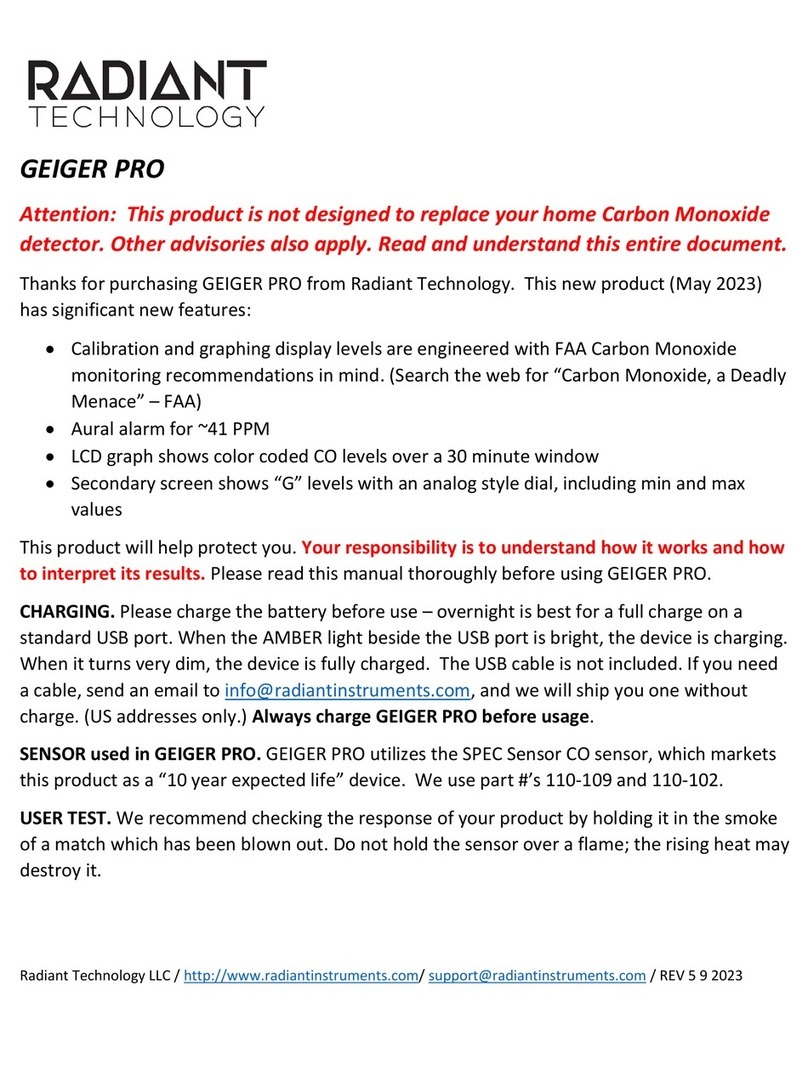
Radiant
Radiant GEIGER PRO manual

Omntec
Omntec FuelCheck Installation & operating manual

Anaheim Scientific
Anaheim Scientific S660 user manual
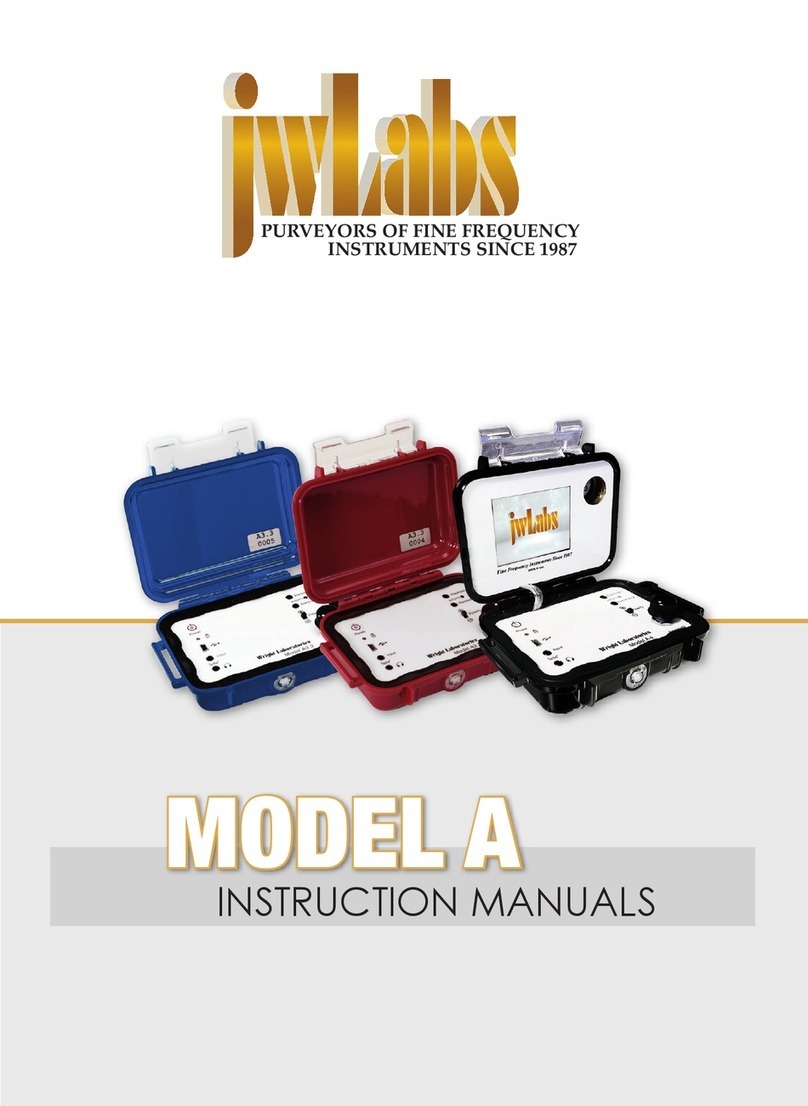
jwLabs
jwLabs A3 Instruction manuals

Berthold
Berthold DuoXpert LB 476 Level+ operating manual

Air Mentor Intelligence
Air Mentor Intelligence Air Mentor 2 user manual


